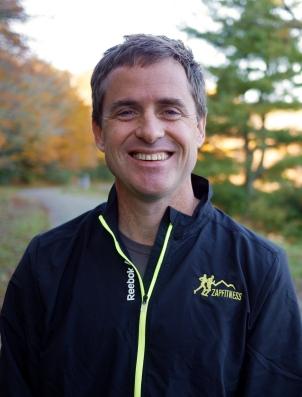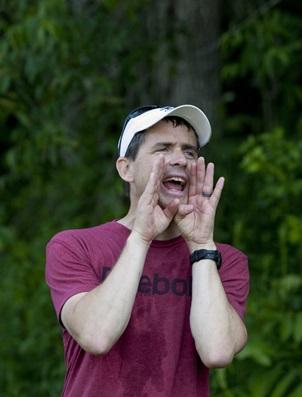One of the real stories of the 2018 Boston Marathon will be how Americans did so well when athletes from Ethiopia and Kenya collapsed in the brutal conditions. The successes, a some noted, were among American’s club system, clubs such as Hansons Brooks Distance Project, HOKA’s Northern Arizona Elite, and the focus of this story, Reeboks’ ZAP Fitness. What is most fascinating is that these clubs were all the products of someone, or someones with a dream, and a running brand that got the vision thing.
Reebok ZAP Fitness has been sponsored by Reebok since 2005. Located in Boone, North Carolina, a college town on the top of a mountain, the runners live at ZAP full time, train full time, and contribute to the camp with their sweat equity. ZAP Fitness, a non profit foundation established in 2001 by Zika Rea and her late husband, runner, Andy Palmer.
RelatedPosts
Pete Rea, one of three coaches at Reebok ZAP Fitness, spoke to @runblogrun on Tuesday about the success the ZAP Fitness runners Tyler Pennel, who was 4th, Nicole DiMercuiro who as 6th and Joanna Thompson, who was 10th in the elite race and 11th overall.
 Pete Rea, photo courtesy of Reebok ZAP Fitness
Pete Rea, photo courtesy of Reebok ZAP Fitness
 Pete Rea, photo by Reebok ZAP Fitness
Pete Rea, photo by Reebok ZAP Fitness
RunBlogRun, #1: To start Pete, why don’t you give us your impressions on how your team did yesterday at the Boston Marathon?
Pete Rea: I have been coaching for more than 20 years, and I have never seen the conditions I saw yesterday. We live in on a mountain in Boone, North Carolina. Our winters are New Englandesque. When we realized that Monday was not going to be a PR day, I told Tyler, Nicole and Joanna to put your watches away. On Monday, they needed to run for place, and not for time. They needed to be increadibly conservative, run behind someone, as long as they could. There would be lots of carnage. The overall number of people who imploded would be huge. They moved from the 30s to the 20s, to the teens, and all were in the top finishers after that. I am very excited for Nicole, Joanna and Tyler.
RunBlogRun, #2: When you pick an athlete for your club, what is your criteria?
Peter Rea: Ours is one of few training groups, where all the athletes live together. When you live at Zap, we look for athletes who can live and work together. Those skills are more rare than you might imagine. Boone is college town, and a full time running center on dirt road in mountains. We look for athletes who are pretty consistent improvement over college years. We would look more at a young athlete who has gone from 14:20 for 5k to 13:40 for the 5k. I would be less interested in an athlete who ran 13:40 as a sophmore, then did not improve again. We also look at under represented universities. I would look at an athlete, say from the University of Maine, who has run 14:20.
RunBlogRun, #3: Tell us about your marathon training program?
Peter Rea: Our marathon program is very Bill Squiresesque. We build around higher volume, but not just mileage. Almost all of our runs has some gear changing runs. We do stuff that is a little quicker, a bit slower, then easier. We like sustained moderate running. We are driven by all that Bill Squires created. Our training is in ten day cycles. We have a long run every ten days, a medium long run every ten days, and a tempo run every ten days. This gives us a bit more rest. We get too locked into the seven days. If you are running 120 miles a week. And the ten day cycle works , when you run for a living. It is a tougher for everyday working folks. I tell adult campers the challenge to a ten day cycle is called a job.
 Pete Rea, photo courtesy of Reebok ZAP Fitness
Pete Rea, photo courtesy of Reebok ZAP Fitness
RunBlogRun, #4: The weather was the big story on Monday, what did you tell your athletes? How did you prepare them?
Peter Rea: It took a few days for the athletes to realize that the big PR breakthrough day was not going to happen. They had to stop thinking about the time, and thinking more about how to compete. More so now, than ever before, they had to be concerned about racing for racing’s sake. Monday would be purely for place. I reminded them about the time Jack Fultz spoke to the club. Jack Fultz won in 1976 Boston ( “the Battle of the Hoses”). Monday would be the slowest time since 1976. Many were freaking out. I told them to embrace it. I told them to realize that a PB would not happen. They needed to compete for place. My final thoughts were compete above your shoulders the first 18 miles, and the last eight, complete below your shoulders. It is all guts the last eight.
For example, Tyler Pennel had run five marathons. He won his first race, the Twin Cities Marathon, which was the US champs. Then, he competed in the Olympic Trials, NYC 2016, Fukuoka in December 2017 and now Boston. Tyler had struggled to close the last 5k, so, in Boston, he needed to finish well. I did not care if he was 10th or 50th, I wanted him to close really well. Tyler closed the last 10k , when the rest were running backwards. He was patient and finished well. Nicole DiMercurio (6th), I was most proud of the fact that she ventured out on her own, in 15th and 16th in the middle of the wind, and moved up catch those in front of her, one by one, by Cleveland Circle. For Joanna (10th elite/11th), I was proud of how she gutted out the second half, especially after heartbreak hill.
I think, for the most part, running for place means that the coach has to get the athlete to buy into removing the watch from the scenario. It is not about time and splits. An athlete needs to be smart, racing individuals. Our running culture, is so locked into the last bloody split in the run that they do. I try to be a coach who pushes back from technologoy, listening to the body, and running on feel. That is what I learned from Bill Squires. Tyler Pennel did not, in fact, wear a watch in Boston. He decided to race people, not the clock, and beat people who are quite a bit better than you. Tyler Pennel beat Steven Sambu, a 26:45 guy, who imploded.
RunBlogRun, #5: Give me three lessons you learned from Boston in 2018.
Pete Rea: Here are my three lessons to learn from Boston:
1. Be a student of your distance and course (we ran course six weeks ago on a cold and windy day) in terms of execution and energy utilization.
2. Have a plan willing to execute, most people throw plans out window when it gets tough, you have to be willing to execute.
3. You are alive, and you can run. Appreciate that. The night before the race, Dave McGillivray, the Bosotn Race Director, discussed the upcoming race and the challengeding conditions. He had people in tears, at the technical meeting. He reminded people that they need to understand and appreciate that you are here, alive and running. You are living, you are very fortunate. Whether you run six hours or you 2 hours ten minutes in the marathon. Appreciate all you have when you perform. You are alive.
RunBlogRun, 6: What is the Reebok relationship with ZAP Fitness?
We have been with Reebok since 2005. The first gentleman at Reebok we dealt with was Patrick Joyce, who told us that, while he likes the post collegiate aspect of the club , for him and Reebok, that ZAP fitness worked with athletes of every age and ability, held retreats, hosted triathlon groups. Reebok liked that we worked with people who had never finished a 5k before. We had campers who were 18 and a camper who was 85. The campers saw that world class athletes like Tyler Pennel were mowing the grass and helping serve the meals.
RunBlogRun, #7: How did you meet Bill Squires?
Bill Squires was the coach of Andy Palmer, the late husband of my wife Zika. Zika and Andy founded ZAP. Andy was a wonderful man, a sports psychologist, who ran with Bill Rdogers. Squires was his coach. Zika reached out to coach Squires a few years later and Squires did the ” I don’t coach anymore.” When she reminded Coach that he had coached her late husband, Squires responded, ” Oh god, you pulled out the dead husband.” So, Squires coached Zika and she did well. I truly believe that Coach Bill Squires is the most successful American coach ever. He would send Zika workout once a week, in an envelope, on a scrap of paper each week with the weeks’ workouts.
A post shared by ZAP Fitness (@zapfitness_reebok) on
Author

Larry Eder has had a 52-year involvement in the sport of athletics. Larry has experienced the sport as an athlete, coach, magazine publisher, and now, journalist and blogger. His first article, on Don Bowden, America's first sub-4 minute miler, was published in RW in 1983. Larry has published several magazines on athletics, from American Athletics to the U.S. version of Spikes magazine. He currently manages the content and marketing development of the RunningNetwork, The Shoe Addicts, and RunBlogRun. Of RunBlogRun, his daily pilgrimage with the sport, Larry says: "I have to admit, I love traveling to far away meets, writing about the sport I love, and the athletes I respect, for my readers at runblogrun.com, the most of anything I have ever done, except, maybe running itself." Also does some updates for BBC Sports at key events, which he truly enjoys. Theme song: Greg Allman, " I'm no Angel."
View all posts




















